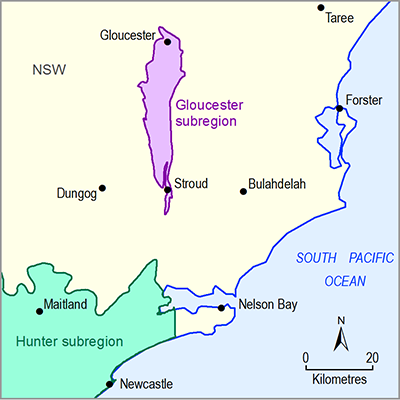This section describes the potential impacts on, and risks to, ecological, economic and sociocultural water-dependent assets from potential hydrological changes due to additional coal resource development. These were assessed using:
- overlay analysis, whereby asset polygons (or lines or points) are intersected with a nominated zone of potential hydrological change to identify whether the asset is potentially subject to that hydrological change
- qualitative mathematical models derived from expert elicitation
- quantitative mathematical models (receptor impact models) derived from expert elicitation and based on the qualitative mathematical models.
Details of the compilation of the Gloucester water-dependent asset register (Bioregional Assessment Programme, 2017) are reported in companion product 1.3 for the Gloucester subregion (McVicar et al., 2015). The spatial layers representing the mapped extents or potential extents of the Gloucester subregion water-dependent assets, which are used in the overlay analysis, are contained within the Gloucester subregion water-dependent assets database (Bioregional Assessment Programme, Dataset 1).
As described in companion product 2.7 for the Gloucester subregion (Hosack et al., 2018), receptor impact models were developed for two landscape classes in the ‘Riverine’ landscape group: ‘Perennial – gravel/cobble streams’ and ‘Intermittent – gravel/cobble streams’. Qualitative models were developed for the groundwater-dependent ecosystem (GDE) landscape classes. Overlay analysis can identify assets that are unlikely to be impacted by surface water or groundwater changes, based on the lack of intersection with the zone of potential hydrological change. The zone of potential hydrological change is defined in Section 3 .3.
The impact and risk analysis uses different estimates of hydrological change (5th, 50th (median) and 95th percentiles) to give an indication of the likelihood of hydrological changes to different types of water-dependent assets present in the zone of potential hydrological change. The principal focus of the analysis is the median (50th percentile estimate). However, the 5th percentile is shown in order to rule out potential impacts as being very unlikely while the 95th percentile can be used to show where hydrological changes (although not necessarily ecological impacts) are very likely.
The analysis of impacts and risks considers each group of water-dependent assets separately – ecological, economic and sociocultural. Each subgroup of ecological assets is described separately – ‘Surface water feature’, ‘Groundwater feature (subsurface)’ and ‘Vegetation’. To improve clarity, assets in the ‘Vegetation’ subgroup are further divided into two classes: ‘Groundwater-dependent ecosystem’ and ‘Habitat (potential species distribution)’. Economic assets are separated into two classes: ‘Groundwater management zone or area (surface area)’ and ‘Surface water management zone or area (surface area)’. Potential hydrological changes to all non-petroleum and gas bores in the zone of potential hydrological change are also considered. The intersection of sociocultural assets with the zone of potential hydrological change is then described, and potential for impact assessed.
The impact and risk analysis uses a combination of summary tables, maps of modelled hydrological change within assets, plots of cumulative asset extent and degree of modelled hydrological change, and narrative. The spatial extent and number of water-dependent assets means that not all assets can be mapped and assessed in this product. Potential impacts to individual assets can be visually explored at www.bioregionalassessments.gov.au/explorer/GLO/assets. Finally, this section describes impacts on and risks to assets due to potential hydrological changes for only that part of the coal resource development pathway (CRDP) that was able to be modelled. Section 3. 6 of this product provides commentary for that part of the CRDP that was not modelled (Gloucester Gas Project Stage 2 and beyond).

Product Finalisation date
- 3.1 Overview
- 3.2 Methods
- 3.3 Potential hydrological changes
- 3.4 Impacts on and risks to landscape classes
- 3.5 Impacts on and risks to water-dependent assets
- 3.6 Commentary for coal resource developments that were not modelled
- 3.7 Conclusion
- Citation
- Acknowledgements
- Contributors to the Technical Programme
- About this technical product
